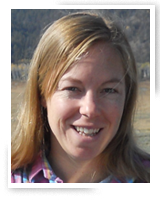Kimberley Taylor
RESEARCH OVERVIEW:

Wildfire regimes have shifted over time in response to both climate and humans. Historically
humans have both increased fire frequency by using it as a tool for clearing land
and decreased fire frequency by instituting fire suppression policies. Recently humans
have had a more indirect effect on fire regimes by introducing nonnative plants that
can change the fire frequency or intensity in their introduced region. My research
will focus on examining the interactions between nonnative plants, fire regimes and
climate. We hope to combine fire models and field data to predict changes in fire
regimes as both plant distributions and climates change in the future.
Specifically, I am examining two species that prosper after fire and reportedly have
the capability of changing the fuel dynamics when they invade a new area. In the
sagebrush steppe of the Upper Snake River Plain in Idaho, I am examining the response
of cheatgrass (Bromus tectorum) to a range of fires that occurred between one and 16 years ago. It is believed
that cheatgrass creates a positive feedback loop with fire by increasing fine fuels
and fuel continuity, thus increasing fire risk, and then increasing in abundance after
fires. This cycle has been seen in heavily grazed areas throughout the Great Basin
where cheatgrass is common. I hope to determine if the same cycle exists in less
disturbed sagebrush steppe.
My second study species, lodgepole pine (Pinus contorta), is an aggressive invader in New Zealand and Patagonia, however it is native here
in Montana. It is also a fire adapted species that can create dense stands with high
woody fuel loads that may increase fire intensity. Lodgepole is invading shrub steppe
and grassland in the Southern Hemisphere, whereas there are many sites in the Greater
Yellowstone Area where lodgepole stands do not invade sagebrush or grassy meadows.
My research aims to determine what factors prevent invasion into Montana meadows yet
allow invasion in the nonnative range and how this relates to fire.
Recent Publications:
Taylor K, Maxwell BD, Pauchard A, Nuñez M, Peltzer DA, Terwei A, and Rew LJ (Under review) Drivers of plant invasion vary globally: evidence from pine invasions within six ecoregions.
Taylor K, Brummer TJ, Lavin M, Rew LJ and Maxwell BD (2014) Bromus tectorum response to fire varies with climate conditions.Ecosystems, 17(6), 960-973.
Taylor K, Brummer T, Taper ML, Wing A, and Rew LJ (2012) Human-mediated long-distance dispersal: an empirical evaluation of seed dispersal by vehicles. Diversity and Distributions, 1–10
Taylor K, Pollnac F, Brummer T, Mangold J and Rew LJ (2011) Washing vehicles to prevent weed seed dispersal. MontGuide MT201106AG Montana State University.
Taylor K, Mangold J and Rew LJ (2011) Weed seed dispersal by vehicles. MontGuide MT201105AG Montana State University.
